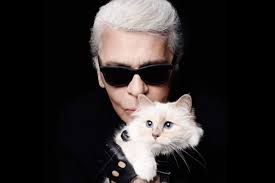
“What becomes a legend most?”
Those of a certain vintage know the answer is Blackglama mink, as the provocative ad of the 1970s proclaimed.
But what really makes someone legendary is something far more abstract – transcendence.
Karl Lagerfeld – who died Feb. 19 in Paris at what is believed to be 85 – was such a legend. As creative director, he transformed the houses of Fendi and Chanel and, in so doing, transformed himself – transcending the fashion world to become a symbol for the wider public of reinvention and a superb work ethic.
You have to wonder how much of that capacity for reinvention was born of a childhood in Nazi Germany, where his father, Otto, was a managing director of the German branch of the American Milk Products Co. Perhaps the drive to self-determination was more the effect of his influential mother, Elisabeth, whose advice to her son, the youngest of the three Lagerfeld children and the only boy, could be summed up as this: Be brilliant and don’t dawdle about it.
To that end, the teenage Lagerfeld took himself off to Paris, where without any art or fashion school education he won the 1954 International Wool Secretariat (now the International Woolmark Prize) in the coat category, then built an impeccable résumé at Pierre Balmain, Jean Patou, Krizia, Ballantyne, Charles Jourdan and Chloé. It was at Chloé, where he remained for more than 10 years, that he exhibited the strategy that would be the hallmark of his work at Fendi, beginning in the mid-1960s, and then at Chanel, where he arrived in 1982. (Two years later, he launched his own Karl Lagerfeld line.)
In each case, Lagerfeld made fashion sexy and fun. Think of what he did alone for bouclé, Chanel’s once staid signature fabric. Lagerfeld gave it color and edge – distressing it, angling it, saturating it in pastels.
The Chanel shows became events; their ads, mini motion pictures. At the same time he was transforming iconic brands, he was rebranding himself. He lost more than 90 pounds and wrote a book about it, “The Karl Lagerfeld Diet” (2002). He dressed in white Hilditch & Key shirts, offset by black – suits, fingerless gloves and glasses.
He created a private haven for himself and Choupette, his beloved Birman cat and an Instagram star with her own maids and diamonds, in a Paris apartment said to contain 300,000 books.
If Lagerfeld offered an example of how to reinvent yourself, developing a classic, timeless style, he also showed an indulgent, entitled culture the way to a no-nonsense work ethic. Even as he was dying of pancreatic cancer, he kept working. The more you work, he believed, the more ideas you’ll have.
In this, he never pitied himself.
“Please don’t say I work hard,” he told Susannah Frankel of The Independent. “Nobody is forced to do this job, and if they don’t like it they should do another one. People buy dresses to be happy, not to hear about somebody who suffered over a piece of taffeta.”
Karl Lagerfeld made all those who were touched by his art very happy indeed.
